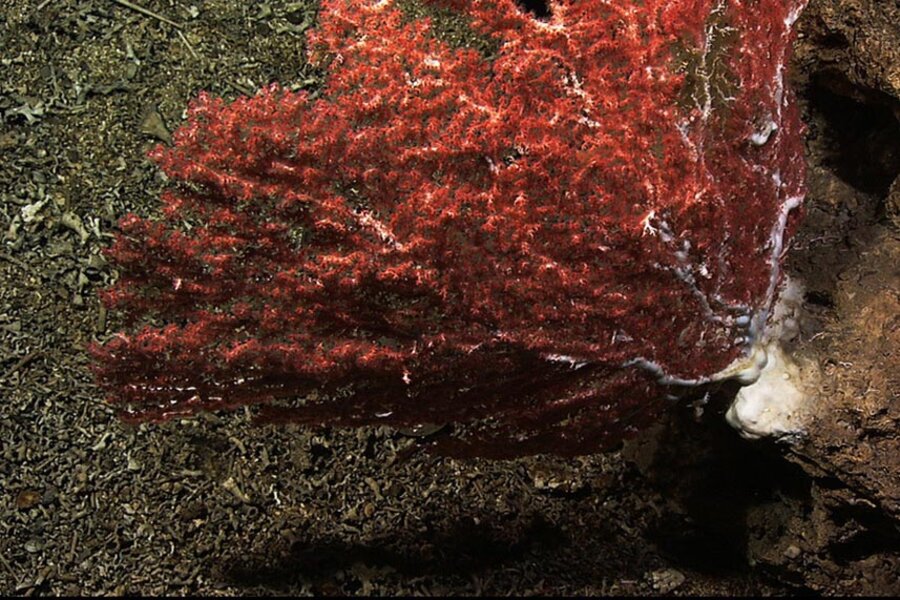Why US might protect 38,000 miles of coral habitat in middle of Atlantic
Loading...
A panel that oversees commercial and recreational fishing along the United States' mid-Atlantic coast has approved a plan to protect 38,000 square miles of deep-sea canyons and surrounding sea floor from bottom-trawling and other fishing techniques that destroy sea-floor habitats.
It marks the first time that one of the nation's eight fisheries-management councils has exercised its authority to protect deep-sea-coral habitats in its jurisdiction, say fisheries-policy specialists.
The panel, the Mid-Atlantic Fisheries Management Council, voted Wednesday afternoon to recommend the restrictions. They cover 27 deep-sea canyons divided into 15 protection zones. The canyons run from the edge of the continental shelf and down the continental margins to the deep-ocean floor.
Like their shallow-water counterparts, corals in these canyons serve as nurseries for commercially valuable fish, such as red crab, lobster, flounder, and hake. They also host a range of creatures unique to the coral beds, which some researchers have dubbed the old-growth forests of the deep ocean.
The canyons host other habitats, such as cold seeps. There, hydrogen sulfide, methane, and other gases bubble up through the sea floor to nourish creatures that rely on chemicals, rather than sunlight, for energy.
The panel's move is preemptive, notes Brad Sewell, senior attorney with the Natural Resources Defense Council's Oceans Program.
"These resources are generally pristine," he says, noting that high-demand fish species in the region generally don't live in the canyons, so few if any fishing interests in the region use the deep-sea gear needed to exploit canyon resources.
But the gear needed to fish at least partway into the canyons exists and is used elsewhere around the world, including off the coast of Alaska, Mr. Sewell adds.
And consumer tastes in fish change.
"You don't know when some fish will become a new delicacy in Asia or somewhere else, and a market will explode," he says.
Scientific interest in deep-sea corals, which are found at depths of more than 6,000 feet, and their ecological roles has been building for years. Fisherman brought up the first specimens in the late 1700s. But only in the last 30 to 35 years have the tools been available to systematically retrieve samples and study them in detail.
Congress gave regional fisheries management councils the authority to protect deep-sea corals in 2006. Interest in conserving them along the East Coast blossomed after a series of expeditions between 2011 and 2012 mapped many of the canyons and sent remotely-operated submersibles into them to see what sort of marine life they might hold. The expeditions revealed a world of pastel corals, some reaching heights of 15 feet, and a wide array of marine organisms highly adapted to a narrow range in water pressure, temperature, and chemistry.
On one level, protecting these canyons would seem straightforward, given the lack of exploitation at the moment.
"I can't say that it was an easy lift" to reach the point where the Mid-Atlantic Fisheries Management Council was ready to approve the restrictions, Sewell says. "But it's certainly easier to close an area off to fishing that's not being fished."
Although the deep canyons aren't being fished, there was a slight overlap at shallower depths between areas currently fished and the proposed boundaries particularly over the Illex squid, which is caught along the margins of the canyons.
But much of that opposition subsided after representatives were included in a meeting in April to develop a consensus on where the off-limits boundaries should be.
Although the council approved the changes, it still must present them to the National Oceanic and Atmospheric Administration for approval as draft changes, which are subject to a period of public comment.
The expectation is that the new rule will be adopted – a move that could set a precedent for protecting these reefs from other threats, such as deep-sea mining or efforts to find and exploit undersea oil and gas reserves in the region.








